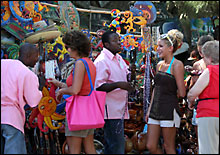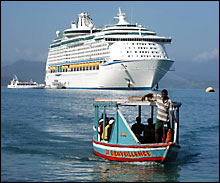| Want to send this page or a link to a
friend? Click on mail at the top of this window. |
 |
|
 |
| SPECIAL PRICE: Tourists from a cruise ship bargain with vendors at
Labadee's beachfront artisan market. Visitors create jobs and bring money into local
economy. Photo/Melanie Stetson Freeman - Staff |
|
WE ARE IN HAITI? Water taxis ferry tourists from cruise ships
to a private beach walled off from locals. Photo/Melanie Stetson Freeman - Staff |
| Could this paradise really be poor,
desperate Haiti? |
______________________________ |
By Danna
Harman / Staff writer of The Christian Science Monitor |
LABADEE, HAITI – It has mango and almond trees, soft white sand, turquoise waters,
and a perfect breeze. It looks like a secret paradise island. It feels like a secret
paradise island.
But, actually, it's Haiti, the poorest country in the hemisphere. Every week, up to
7,000 camcorder-toting tourists, the vast majority of them Americans, come ashore here off
a Royal Caribbean cruise ship for a day of sun, sailing, volleyball tournaments, and
sliding on the "world's largest" inflatable water slide.
"It's the best kept secret in the world," says Melody Hickey, from Columbus,
Ohio. "Its amazing."
Haiti - usually known for its poverty and political instability - is not a typical
holiday destination for the bikini-clad set.
But Labadee seems a world away.
In fact, as far as many of the tourists are concerned, Labadee actually is in a
different part of the world.
"Isn't Puerto Rico part of Haiti?" asks a high school senior from Nashville,
Mich., getting off the ship to get her hair braided.
"I thought we were coming to a place called Hispaniola," says Cindy Roberts
from Madison, Ind., as she bargains for a voodoo bottle at the 'Native Market' set up for
tourists. "But I guess it doesn't matter," she says. "So, it's Haiti."
The tourists have a good excuse for their confusion. "Welcome to Labadee!"
reads the banner - emblazoned with the face of a Johnny Depp look-alike pirate - strung up
on the pier.
A small wooden sign facing away from the incoming crowds reads "Labadee,
Haiti." Most, however, just pass it by in the rush to the Ben & Jerry's ice cream
stand.
The interactive TV monitors in the onboard cabins show the ship moving across the ocean
to an Island clearly marked Haiti. But, the Royal Caribbean's website mystifies the bay as
a "private," and "secret" destination. When it is labeled, they call
it "Labadee, Hispaniola," in reference to the name given to the island by
Christopher Columbus, who, incidentally, thought he was in China when he dropped anchor
here in 1492.
The cruise line doesn't go out of its way to clear up any confusion about the actual
location of its private beach.
"We make no pretense of where we are," says David Southby, Royal Caribbean's
site manager for Labadee. "The real question is 'Where is Haiti?' - and 'What is
Haiti?' If you are honest, even if you tell them, most passengers don't know where they
are, usually."
And, referring to the island as Hispaniola and not Haiti, is merely a marketing tool,
wrote Craig Milan, a senior vice president at Royal Caribbean, in an email exchange.
"It's much like we refer to our port in Bayonne, N.J., as Cape Liberty Cruise
Port," he says. "We were getting the same response about not calling that port
'Bayonne Cruise Port.' "
"I used to be mad about the cruise line trying to mask the identity of
Haiti," says Jean Cyril Pressoir, author of the "Guides Panorama, Haiti"
tour books. "But now, I understand: We have an image problem and this is a way to get
people to give the country a chance. Fair enough. We really need the tourists."
Since 1986, the Royal Caribbean line has provided the largest source of tourism revenue
to Haiti. The cruise company pays the Haitian government $6 per passenger and employs
about 300 locals, including security guards, beach monitors, waiters, cleaners, as well as
some managers. Approximately 200 more locals find work here selling their wares, often at
inflated prices, at the market stalls, or by providing entertainment.
"They certainly could be doing more for the local economy," says Florence
Lelio Joseph, a travel agent in Haiti's capital, Port-au-Prince. She notes that the
foreign operators take most of the profits out of the Caribbean, and import food and other
supplies from elsewhere. But, she admits, in a country where the only other visitors now
are UN staff, aid workers, and ex-pat Haitians visiting home, "everything is
relative."
"It's not my favorite type of tourism, but I recognize that if we were smarter,
we'd have 10 Labadees across the country," says Mr. Pressoir. "Better tourists
enjoy the beach than nothing at all."
And the beach - 260 acres of land - is probably all that these tourists see. Visitors -
who are not issued Haitian visas or immigration cards - are not allowed off the premises,
except on group kayaking and jet ski excursions. The US State Department doesn't
officially object to the visits, despite a travel warning, out since November, that says
"due to the volatile security situation," US citizens should avoid travel to
Haiti altogether.
Greta Urnisk from Pensacola, Fla., has been on 10 cruises to Labadee.
Walking around the now-familiar site in a yellow bathing suit and a yellow Royal
Caribbean fanny pack, she admits she has never set a flip flop out of the gated area.
"What in the world would I want to find out in the mountains?" she asks.
But there are other reactions, too. Ralph and Cathy Oats from Dallas, Texas, first came
to this beach last July, as part of a vacation cruise, and, like many, admit they had no
idea they were in Haiti.
But, jet skiing that day, a chance interaction with some locals got them thinking.
"The desperation we saw in the eyes of the very thin men paddling their boats out to
us to present their handmade trinkets for sale was an impression that never left us,"
says Cathy.
So, in December, when they took a second cruise to Labadee, they came with suitcases of
toiletries and school supplies from their community to donate to a private Canada-based
charity, Hearts Together for Haiti. Started in 1996, the group operates schools, health
clinics, and programs to provide food to residents in the area. Royal Caribbean security
helped transport the donations to nearby Labadee village, a few coves away.
"It's easy to put down the cruise ships and say those folks are oblivious to where
they are and to the suffering around them," says Father John Duarte, who runs Hearts
Together. "But the important thing to do is encourage both individuals and the Royal
Caribbean management to understand the needs here and work with us. Good can come of
this."
Gito Roberts or, as he is known to friends, Ti Gito (little Gito), grew up in Labadee
village, and makes a living ferrying villagers back and forth to coves along the shore in
his cousin's skiff.
He sings jazz songs as he works, dreaming of some day going to New York to hear his
musical idols play.
"I would like to get on one of those big ships and see what America is like,"
he says. He pulls down the donated Royal Caribbean baseball cap he, like about half the
villagers, sports: "... and then I would like to come home immediately."
"All these tourists come here," he points out, "because they, who have
seen a lot, know that there is no lovelier place in the world than my country."
• Ms. Harman is Latin America correspondent for the Monitor and USA Today.
Copyright © 2006 The Christian Science Monitor. Reprinted from The Christian Science
Monitor of Tuesday, January 24, 2006.
| Wehaitians.com, the scholarly journal of
democracy and human rights |

